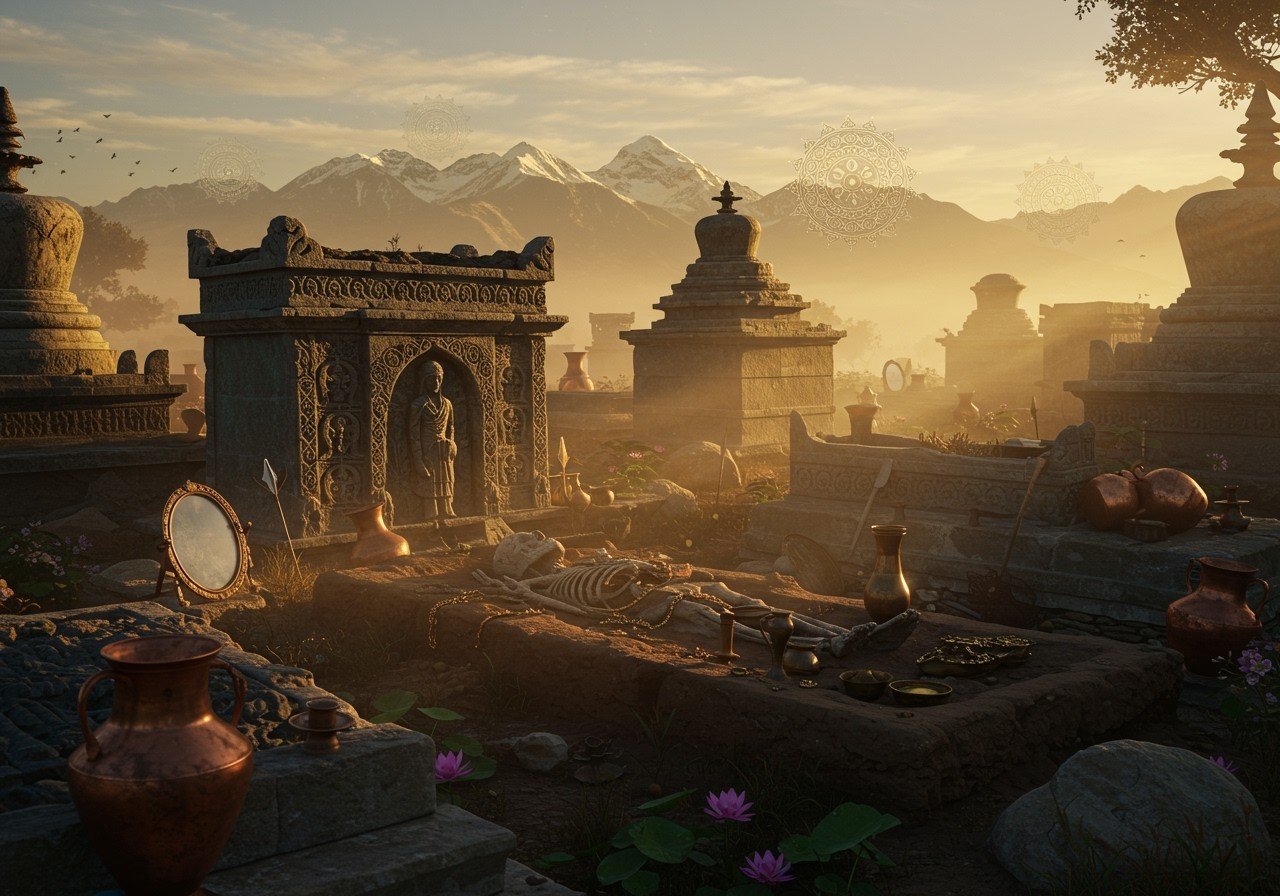
The Gandhara Grave Culture, also known as Protohistoric Cemeteries, offers a fascinating glimpse into the ancient world. Discovered in the 1960s by Pakistani archaeologists, this burial tradition spanned from the 8th century BCE to the 17th century CE across a wide geographical area, primarily featuring inhumations. Its emergence is linked with the introduction of iron technology around 1200-900 BCE. The burial practices, discovered in regions like the middle Swat River valley and Chitral, are believed to align with earlier cultural traditions. This blog post delves into the intricate funerary practices of this culture, exploring their cultural significance and historical context while examining archaeological findings and the reconstruction of these ancient rituals.
Historical Context of Gandhara
Gandhara, an ancient region located in present-day Pakistan and Afghanistan, flourished between the 1st millennium BCE and the 11th century CE. A cultural crossroads, Gandhara was influenced by Greek, Persian, and Indian civilizations, playing a significant role in the spread of Buddhism, as evidenced by numerous stupas and monasteries. Key archaeological sites such as Taxila and the Swat Valley offer invaluable insights into Gandhara’s rich cultural and historical heritage.
Gandhara Grave Culture Overview
The Gandhara Grave Culture is characterized by diverse grave types, including pit graves, cist graves, and chamber tombs. These graves often contain artifacts like pottery, ornaments, and tools, which provide clues about the daily life and social status of the deceased. The orientation of the graves and the positioning of the bodies within them reflect the spiritual beliefs and rituals of the Gandhara people. The construction of the graves, often using stone slabs and bricks, showcases the craftsmanship of the era.
Reconstruction of Gandhara Burial Rituals
Anthropologists and archaeologists play a crucial role in reconstructing Gandhara burial rituals based on grave findings. Grave goods offer insights into the offerings and rituals performed during burial ceremonies. Modern technologies, such as 3D modeling and forensic analysis, assist in reconstructing the physical appearance and health of the deceased. Ethnoarchaeological studies, which compare contemporary burial practices with ancient ones, help draw parallels and gain deeper insights into these rituals.
Cultural Significance of Gandhara Burial Practices
The burial practices of Gandhara hold broader cultural and religious implications. Specific grave goods suggest beliefs in an afterlife and the continuation of daily activities beyond death. The influence of Buddhism is evident in graves containing relics and Buddhist symbols. Funerary rituals served to reinforce social hierarchies and community bonds. Gandhara art, which frequently depicts funerary scenes, provides visual evidence of the rituals performed.
Gandhara Grave Culture Map (Illustrative – Consult Archaeological Resources for Detailed Maps)
While a detailed map requires referencing specific archaeological resources, key sites associated with the Gandhara Grave Culture include Taxila, Charsadda, and Butkara, which have yielded significant grave finds. The geographical distribution of different grave types offers insights into regional variations in burial practices. These sites help us understand the trade networks, cultural exchanges, and migration patterns of the Gandhara people. Ongoing excavations continue to illuminate this fascinating culture.
Preservation and Study of Gandhara Graves
Preserving Gandhara grave sites is paramount. Local and international organizations collaborate to safeguard these archaeological treasures. Ethical considerations are crucial during excavations to ensure respect for the cultural heritage. Digital archives and virtual museums make the Gandhara Grave Culture accessible to a global audience. Interdisciplinary collaboration among historians, archaeologists, and conservators advances the study of Gandhara burial practices. This collaborative approach ensures the preservation and continued study of this important cultural heritage.
Connecting Ancient Traditions with Modern Practices: How Poojn.in Supports Your Ritual Needs
Poojn.in recognizes the profound connection between ancient traditions and modern funeral practices. Inspired by the reverence shown in historical customs like the Gandhara Grave Culture, we provide resources for observing traditional Hindu funeral and memorial rituals with authentic supplies and expert guidance. Our offerings include:
- Pind Daan Samagri Kits: Comprehensive kits containing all the necessary items for Pind Daan rituals. These kits ensure you have everything required for this important ceremony.
- Copper Vessels and Other Essentials: Pure copper vessels for water offerings, traditional white cotton vastras, til (sesame) and other sacred grains, Gangajal, pure ghee, and more. We provide high-quality, authentic materials for your rituals.
- Customized Puja Samagri: Personalized sets for shraddh and other memorial ceremonies, tailored to specific needs and preferences. Our experts can help you create the perfect set for your observances.
Poojn.in provides convenient doorstep delivery across India, ensuring the purity and sanctity of your ritual items. Visit Poojn.in or contact our ritual experts for guidance and support.
Conclusion
Exploring the Gandhara Grave Culture offers a profound understanding of ancient traditions. Their burial practices reflect the beliefs, values, and artistry of the Gandhara people. As a cultural bridge influenced by diverse civilizations, Gandhara’s funerary practices showcase this unique blend. Studying these graves provides insights into daily life, social structures, and spiritual beliefs. Preserving and studying these sites is crucial for our shared heritage. Learn more about rituals and find essential puja items at Poojn.in.


